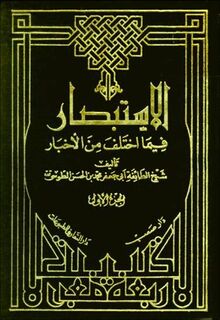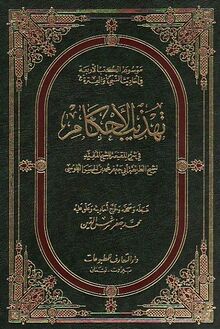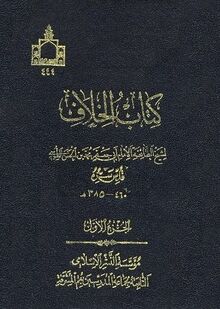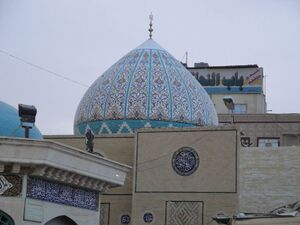Al-Shaykh al-Tusi
 The Tomb of al-Shaykh al-Tusi in the al-Shaykh al-Tusi Mosque in Najaf | |
| Personal Information | |
|---|---|
| Full Name | Muhammad b. al-Hasan b. 'Ali b. al-Hasan |
| Well-Known As | Shaykh al-Ta'ifa, al-Shaykh al-Tusi |
| Well-Known Relatives | Al-Hasan b. Muhammad al-Tusi (son) |
| Birth | Ramadan 385/Septemeber/October 995 |
| Residence | Khorasan, Baghdad, Najaf |
| Studied in | Baghdad |
| Death | Muharram 22, 460/December2, 1067 |
| Burial Place | Najaf |
| Scholarly Information | |
| Professors | al-Shaykh al-Mufid, al-Sharif al-Murtada, Ibn Hashir |
| Students | Abu l-Salah al-Halabi, Abu l-Fath al-Karajaki |
| Works | Tahdhib al-ahkam, Al-Istibsar fi ma ikhtalaf min al-akhbar, Al-Fihrist (al-Tusi), Al-Rijal (al-Tusi), Al-Tibyan fi tafsir al-Qur'an, Al-Khilaf fi l-ahkam, Misbah al-mutahajjid |
Muḥammad b. al-Ḥasan b. ʿAlī b. al-Ḥasan (Arabic: محمد بن الحسن بن علي بن الحسن) (b. 385/995 in Tus, d. 460/1067 in Najaf), better known as al-Shaykh al-Ṭūsī (Arabic: الشيخ الطوسي), was one of the greatest Shi'a jurists and compilers of hadith. He has written many works in the fields of theology and tafsir. For his great contributions and tremendous influence, he received the honorable title of al-Shaykh al-Ṭāʾifa (الشيخ الطائفة) (the chief or head of the Shi'a).
He moved from Khorasan to Iraq at the age of 23 and benefited from teachers like al-Shaykh al-Mufid and al-Sharif al-Murtada. The Abbasid caliph appointed him to the chair of Theology of Baghdad. When the library of Shapur was set on fire, he had no choice but to move to Najaf and establish a seminary there. Al-Shaykh al-Tusi became the marja' of the Shi'a after the demise of al-Sharif al-Murtada.
His jurisprudential theories and writings such as al-Nihaya, al-Khilaf and al-Mabsut are consulted by jurisprudents. His important exegesis is al-Tibyan. Al-Shaykh al-Tusi was also an expert in other fields such as rijal, theology and principles of jurisprudence and his books are references for religious studies. He started to transform Shi'i ijtihad and expanded its discussions and made it independent from Sunni ijtihad. His most famous student is Abu l-Salah al-Halabi.
Life
Muhammad b. al-Hasan was born in Tus one of the important city of Khorasan in Ramadan 385/Septemeber/October 995, four years after the demise of al-Shaykh al-Saduq and the same year of the demise of Harun b. Musa Talla'ukbari.[1] His kunya was Abu Ja'far and since the kunya of both al-Shaykh al-Kulayni and al-Shaykh al-Saduq also was Abu Ja'far, he is sometimes called the third Abu Ja'far.
Al-Shaykh al-Tusi spent the first part of his life in Khorasan and moved to Baghdad at the age of 23. In Baghdad, he studied under leading Shi'a scholars such as al-Shaykh al-Mufid, al-Sharif al-Murtada, and Ibn al-Ghada'iri.[2] The Abbasid caliph of the time eventually appointed him to the principal chair of theology in Baghdad, where nearly three-hundred students would attend his classes.
Following the demise of al-Sharif al-Murtada, al-Shaykh al-Tusi took over the leadership of the Shi'a.
After his house and library were burnt down in the sectarian conflicts of 449/1057-8, and the decline of the Buyid dynasty, al-Shaykh al-Tusi moved to Najaf. There, he established a Shi'i scholarly circle which led to the formation of the Islamic Seminary of Najaf.[3]
Scholarly Position
Al-Shaykh al-Tusi was the leader of Shi'a jurisprudence. He attained the station of ijtihad in both fiqh and usul al-fiqh. From the Four Books, al-Shaykh al-Tusi is the author of both al-Istibsar and Tahdhib al-ahkam.
The ideas and works of al-Shaykh al-Tusi had overshadowed Shi'a scholarship and no one opposed his opinions until the time of Ibn Idris (d. 598/1201-2).[4] His book, al-Nihaya, was the main source of teaching in Shi'a scholarly circles until al-Muhaqiq al-Hilli (d. 676/1277-8) wrote Shara'i' al-Islam.
Al-Shaykh al-Tusi wrote in nearly all fields of Islamic sciences. His works are a unique resource for later generations because many of the sources he used were destroyed when Shapur library was burned.[5]
Teachers
Al-Tusi studied with many teachers, but the following five figures are the ones he refers to most:
- Abu 'Abd Allah Ahmad b. 'Abd al-Wahid b. Ahmad al-Bazzaz, known as Ibn Hashir (d. 423/1031-2)
- Ahmad b. Muhammad b. Musa, known as Ibn Salt al-Ahwazi (d. 408/1017-8)
- Abu 'Abd Allah al-Husayn b. Ubayd Allah b. al-Ghada'iri (d. 411/1020-1)
- Abu l-Husayn Ali b. Ahmad b. Muhammad b. Abi Jayd al-Qummi (d. after 408/1017-8)
- Abu Abd Allah Muhammad b. Muhammad b. Nu'man, known as al-Shaykh al-Mufid (d. 413/1022).[6]
Students
It is reported that al-Tusi had over 300 Shi'ite students and many other Sunni ones. The most well-known of them are:[7]
- Abu l-Salah al-Halabi, a prominent faqih and theologian and the author of al-Kafi fi l-fiqh
- Muhammad b. 'Ali al-Karajuki, the author of Kanz al-fawa'id
- His son al-Hasan b. Muhammad al-Tusi, known as "al-Mufid al-Thani".
- Muhammad b. al-Hasan al-Fattal al-Nayshaburi, the author of Rawdat al-wa'izin wa basirat al-mutta'izin.



Works
Al-Shaykh al-Tusi authored over fifty books in the fields of fiqh, hadith, theology, and tafsir. Some of his important works are as follows:
- Al-Istibsar fi ma ukhtulif min al-akhbar: This compilation of hadith is one of the Four Books and one of the main sources of Shi'a fiqh.
- Al-Tibyan fi tafsir al-Qur'an : This book is the first commentary of the Qur'an which compiles all aspects of Quranic Sciences.
- Tahdhib al-ahkam: This hadith compilation is one of the Four books.
- Misbah al-mutahajjid: This is one of the most important and reliable Shi'a resources for rituals, practices, ziyarah and prayers.
- Uddat al-usul: The first part of this book is about the principles of religion, and the second is about the principles of fiqh.

Thoughts and Intellectual and Religious Position
Al-Shaykh al-Tusi was among the leaders of intellectualism in Baghdad and followed the method of his teachers, al-Sayyid al-Murtada and al-Shaykh al-Mufid and perfected it. Al-Shaykh al-Tusi wrote books in different branches of religious studies and since he was influential in Shi'a society and had many students, could make a lasting influence over Shi'a scholars. Ijtihad and intellectualism in Shi'a fiqh and beliefs prevailed among Shi'a due to the efforts of al-Shaykh al-Tusi who ended the dominance of several centuries of Akhbarism.
Establishment of the Seminary of Najaf
After the invasion of Seljuk Turks to Baghdad and its following events like burning of the Shapur library and the fight between Shi'a and Sunnis in Baghdad, al-Shaykh moved to Baghdad and began his scientific activity in that city and the great seminary of Najaf was established due to his efforts. Al-Shaykh could bring order to the disordered educational situation in Najaf and hold study circles. Few people who had either accompanied Shaykh to Najaf or had heard his fame joined him and soon Najaf became the intellectual and scientific center of Shi'a. However, some believe that study circles were formed before Shaykh went to Najaf and his role was to bring order and stability to the seminary of Najaf.
The Role of al-Shaykh al-Tusi in Perfection of Shi'a Fiqh
Introducing intellectual and discursive method for understanding the rulings of fiqh is usually considered as the most prominent achievement of al-Shaykh al-Tusi in the history of Shi'a fiqh. Before al-Shaykh al-Tusi, the prevalent method in fiqh was hadith-oriented. In al-Mabsut, al-Shaykh al-Tusi benefitted from ijtihad approach to understand rulings from hadiths based on the usuli principles. Al-Shaykh al-Tusi's method had a great influence over the historical course of Shi'a fiqh and it was unrivaled among Shi'a faqihs for ages later. After al-Shaykh al-Tusi, even his rulings were accepted by scholars and no one dared to oppose his opinions until Ibn Idris (d. 598/1201-2) opened criticism against him.[8]
Solving apparent contradictions between hadiths received from Imams (a) was among the major concerns of al-Shaykh al-Tusi. He wrote Tahdhib al-ahkam and al-Istibsar and collected contradictory hadiths and interpreted and explained these contradictions and proposed a method for solving them and understanding the rulings from hadiths. Al-Shaykh al-Tusi considered the usage of comparative fiqh. His major work in the regard is al-Khilaf fi l-ahkam.
Innovation in Writing Commentary on the Qur'an
Al-Shaykh al-Tusi is the author of al-Tibyan fi tafsir al-Qur'an, which was a model for later Shi'a commentaries. It is the first complete commentary of the Qur'an written by a Shi'a and includes all the chapters of the Qur'an. It is distinguished from previous commentaries because in al-Tibyan, al-Shaykh al-Tusi considered the opinions of other Shi'a and Sunni scholars, discussed about the opinions of other exegetes, benefitted from pre-Islamic Arabic literature, gave information on difficult words of the Qur'an and mentioned the differences among recitations and issues in fiqh, theology, and rhetorics in verses of the Qur'an. Shi'a commentaries before al-Shaykh al-Tusi only mentioned hadiths about the verses of the Qur'an.[9]
The most important feature of al-Shaykh al-Tusi's method in exegesis was his ijtihad and intellectualism in interpretations of the Qur'an which made it different from simple hadith-oriented approach of previous exegetes. Al-Shaykh al-Tusi brought proofs from the verses of the Qur'an that the Qur'an is an understandable text for human intellect and did not accept hadiths which considered referring to hadiths as the only way to understand the Qur'an.[10]
Demise
Al-Shaykh al-Tusi lived for 12 years in Najaf and passed away in Muharram, 460/December, 1067. According to al-Shaykh's will, he was buried in his house,[11] and the house was converted into a mosque.
The al-Shaykh al-Tusi mosque, which is also called Jami' al-Shaykh al-Tusi, is one of the most famous mosques of Najaf. It has been reconstructed and repaired several times, and is used by the professors and scholars of the Islamic Seminary of Najaf as a place for holding lectures.[12]
Notes
- ↑ Āqā Buzurg, Ṭabaqāt aʿlām al-Shīʿa, p. 161.
- ↑ Āqā Buzurg, Ṭabaqāt aʿlām al-Shīʿa, p. 161.
- ↑ Āqā Buzurg, Ṭabaqāt aʿlām al-Shīʿa, p. 161-۱۶۲.
- ↑ Āqā Buzurg, Ṭabaqāt aʿlām al-Shīʿa, p. 162.
- ↑ Āqā Buzurg, Ṭabaqāt aʿlām al-Shīʿa, p. 161.
- ↑ Ṭūsī, al-Nihāya, p. 31.
- ↑ See: Ṭūsī, al-Nihāya, p. 36-39.
- ↑ Āqā Buzurg, Ṭabaqāt aʿlām al-Shīʿa, p. 162.
- ↑ Ghulāmī, "Nigāhī bi nukhustīn tafsīr-i jāmiʿ", p. 85-86.
- ↑ Ghulāmī, "Nigāhī bi nukhustīn tafsīr-i jāmiʿ", p. 85-86.
- ↑ Āqā Buzurg, Ṭabaqāt aʿlām al-Shīʿa, p. 162.
- ↑ ʿAlawī, Rāhnamā-yi musawwar-i safar-i zīyāratī-yi Iraq, p. 150.
References
- ʿAlawī, Sayyid Aḥmad. Rāhnamā-yi musawwar-i safar-i zīyāratī-yi Iraq. Qom: Maʿrūf, 1389 Sh.
- Āqā Buzurg, Muḥammad Muḥsin. Ṭabaqāt aʿlām al-Shīʿa. Qom: Ismāʿīlīyān, [n.d].
- Ghulāmī, Ṭāhira. 1391 Sh. "Nigāhī bi nukhustīn tafsīr-i jāmiʿ wa kāmil-i jahān-i tashayyuʿ murūrī bar kitāb-i shaykh al-Ṭūsī wa tafsīr-i Tibyān." Majalla-yi Kitāb-i Māh-i Dīn 176.
- Ṭūsī, Muḥammad b. al-Ḥasan al-. Al-Nihāya fī mujarrad al-fiqh wa l-fatāwā. Beirut: Dār al-Āndulus, [n.d].
